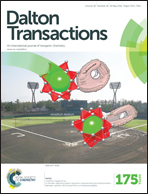Central-metal exchange, improved catalytic activity, photoluminescence properties of a new family of d10 coordination polymers based on the 5,5′-(1H-2,3,5-triazole-1,4-diyl)diisophthalic acid ligand†
Abstract
The rigid and planar tetracarboxylic acid 5,5′-(1H-2,3,5-triazole-1,4-diyl)diisophthalic acid (H4L), incorporating a triazole group, has been used with no or different pyridine-based linkers to construct a family of d10 coordination polymers, namely, {[H2N(CH3)2]3[Cd3(L)2(HCOO)]}n (1), {[Cd2(L)(py)6]·H2O}n (2), {[H2N(CH3)2] [Cd2(L)(HCOO)(H2O)4]}n (3), {[Zn(H2L)]·H2O}n (4), and {[Zn(H2L)(4,4′-bipy)0.5]·C2H5OH·H2O}n (5) (py = pyridine, 4,4′-bipy = 4,4′-bipyridine). 1 constructs a 3D porous network containing two kinds of channels: one is filled with coordinated HCOO− anions, and the other with [H2N(CH3)2]+ cations. The framework of 1 can be described as a rare (5,6,7)-connected net with the Schläfli symbol of (412·5·62)(45·53·62)2(48·53·68·82)2. The Cd(II) ions in 2 are connected through the carboxylate ligands to form a 2D layer, with aperture dimensions of ∼15.1 Å × 16.2 Å. The network of 3 features a 3D (3,4)-connected (6·8·10)2(6·83·102) topology. A 3D network with the (42·6·83) topology of 4 possesses an open 1D channel with the free volume of 29.2%. 5 is a 2D layer structure with the (42·63·8)(42·6) topology. The fluorescence lifetime τ values of 1–5 are on the nanosecond timescale at room temperature. In particular, central-metal exchange in 2 leads to a series of isostructural M(II)–Cd frameworks [M = Cu (2a), Co (2b), Ni (2c)] showing improved catalytic activity for the synthesis of 1,4,5,6-tetrahydropyrimidine derivatives. Based on this, a plausible mechanism for the catalytic reaction has been proposed and the reactivity–structure relationship has been further clarified.


 Please wait while we load your content...
Please wait while we load your content...